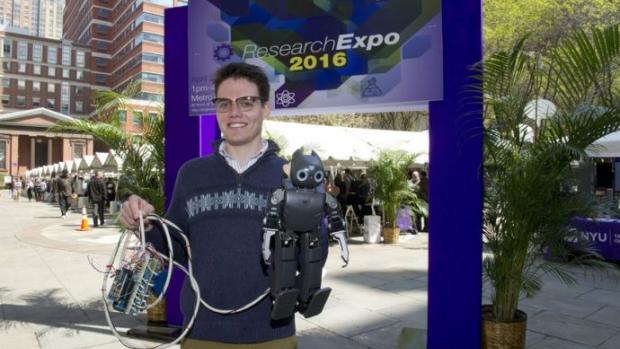Home-Grown Tech
The 2016 Research Expo at NYU Tandon School of Engineering Showcased Strides Being Made Here in Brooklyn

Popular culture often depicts robots in an exaggerated or romanticized manner — either out to do evil (think The Terminator or Blade Runner) or benevolently helping their human companions (R2-D2 of Star Wars fame, for example).
Unlike Hollywood filmmakers, however, engineers are not known for exaggerating or romanticizing. When they conceive of a robotic system, chances are that it will address a pressing societal need in a viable and practical manner. Take the Underground Medium Voltage Cable Splicing Robot on display at NYU Tandon School of Engineering’s 2016 Research Expo, held on April 27. In an ongoing collaboration with Con Edison, a team of Tandon students addressed the fact that the utility company experiences more than 1,000 costly and inconvenient underground distribution outages each year in New York City. When one occurs, underground cable feeders have to be de-energized in order for workers to gain access. The robot developed by the students assists the utility’s workers by splicing the underground cable feeders, and while that might not be glamorous enough to make it to the big screen, it shortens the duration of the outages and prevents them from cascading and affecting consumers.
Other robots on display at the Expo were being used to monitor environmental conditions, relate to children with autism, help measure human metabolic energy expenditure, and more.
Robots are always a big hit with attendees but other crowd-pleasers included a 3D printer (originally marketed to the culinary industry for use with chocolate) that had been modified to produce innovative architectural and structural forms with concrete and a demonstration from Tandon’s SpaceX Hyperloop team, which has designed a pod meant to carry cargo and passengers on a futuristic transportation system.
A panel of expert judges viewed the dozens of exhibits and deemed the first-place winner to be “Streamloading,” a novel method for delivering copyrighted video content to mobile users. In streamloading, videos are broken up into a base layer and one or more enhancement layers. The base layer, which is a fraction of the total video bandwidth, is streamed to users as a coarse grain version; the enhancement layers are then downloaded when and where bandwidth is cheap, adding to the quality of the video but keeping costs down. Second place was taken by an exhibit describing computational hydrodynamics with the use of parallel computational techniques on GPU hardware, while third place went to a project called “Protein-Based Ferrofluids for Theranostic Applications,” which has great potential in the realm of cancer treatment.
In attendance at the Expo were Deputy Borough President for Brooklyn Diana Reyna and New York State Assemblyman Joseph Lentol, both of whom praised NYU Tandon for its role in making Brooklyn a hub of tech innovation. “We are the smart city others look to emulate,” Reyna exclaimed. “Brooklyn is Beta Land!” Lentol praised Tandon’s student body, saying, “We have a talent pool here that is allowing us to overtake Silicon Valley as the heart of Tech Land.”
When Dean Katepalli Sreenivasan took the stage, he affirmed that Tandon had a commitment to high-level research — starting even at the undergraduate level; that commitment was abundantly evident at the Expo, where even the school’s youngest researchers were showcasing impressive projects. The series of undergraduate projects on display included new methods of preventing data loss, a game aimed at aspiring urban planners, and even one that could save lives: one group had created a product aimed at public pool facilities and families with young children — a wireless alarm that could be either pushed or automatically triggered by the motions typically made by a drowning swimmer (learn more about the award-winning capstone projects from our resident student reporter).
The Expo proved, however, that at Tandon, Science, Technology, Engineering, and Math (STEM) learning can start even earlier than the undergraduate years: drawing some of the biggest crowds was NYU’s Center for K-12 STEM Education, which showcased their year-round efforts to get Brooklyn’s schoolchildren involved in building robots, planning smart cities, and more.




